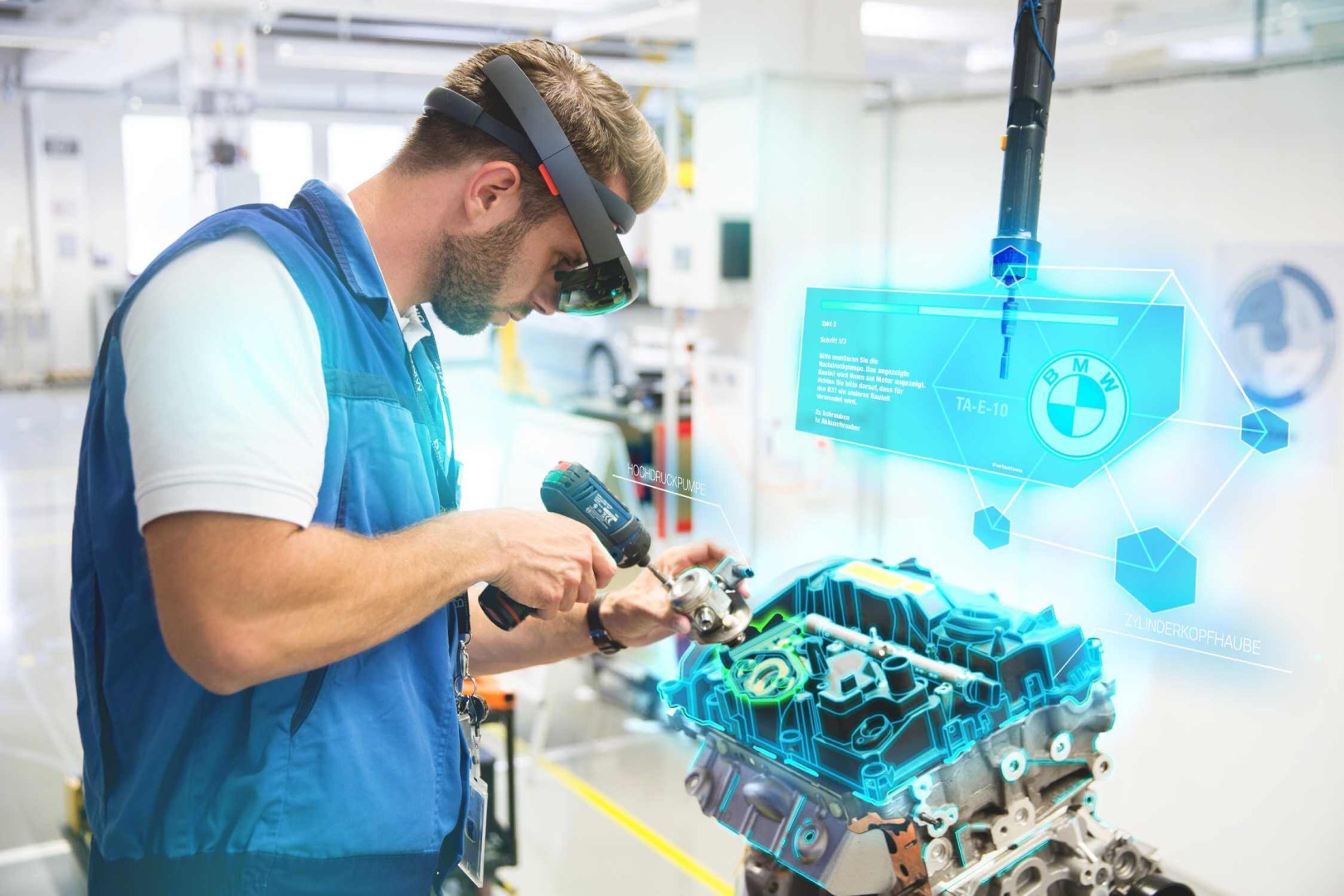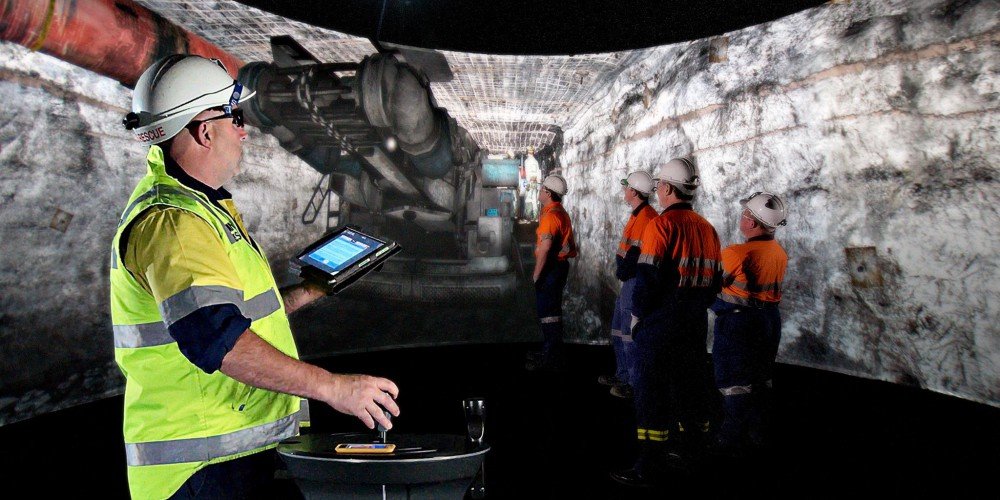TECHNOLOGY
Wearable AR and the Future of Augmented Training

Immersive technologies like augmented reality (AR) can create rich, contextual user experiences in amazing ways.
With technological advancements, the coming years will see greater adoption of AR in the corporate world, ensuring this exciting innovation soon becomes a vital part of our professional lives.
For starters, AR can smoothen processes and optimize learning outcomes for on-the-job training. In this article, we delve into augmented reality training, specifically wearable AR for training as well as the future of AR in the workplace.
What Is Augmented Reality Wearable Technology?

Generally, two types of wearable devices can be used in AR for training. Users can opt for the headset or the smart glass, more precisely called augmented reality glass. While both wearable AR devices have unique merits and disadvantages, augmented reality glasses are typically more immersive and interactive.
The Head Mounted Tablet (HMT)
The HMT connects to a helmet and grants the user a picture-in-picture perspective in their indirect vision. HMTs are handy devices, especially in fields where special technical operations and safety inspections are necessary. This could be applicable to the manufacturing, telemedicine, automotive, and oil and gas industries.
As an HMT wearer, you can receive hands-free cooperation with experts who are connected with you remotely. You can always obtain explicit instructions and training in your ear from these experts, who may also access your vantage point like they were in your shoes.
With this kind of wearable AR device, the user can make documents pop up before their eyes through a small mini-tablet view by issuing simple voice commands. This is particularly useful for digitized workflows and optimized data visualization and is suitable for relaying training.
While HMTs have handy advantages in various fields and in corporate training, they may fall shy of capabilities that permit more complex and graphically intensive applications. It’s fair to say that while conventional computers are more suitable for such complex systems, immersive technology companies are working hard to counter this challenge.
You can be fairly confident that ongoing innovations in wearable AR will soon make HMTs just as powerful as PCs while mounted on your head.
Augmented Reality Glasses
Augmented reality glasses, or smart glasses, are inarguably the most immersive and AR devices that offer remarkable visual appeal. AR glasses can be effectively employed in training because of their capabilities like integrated reality visual guidance that frequently involves stepwise checklists and instructions.
And just like their HMT counterparts, augmented reality glasses allow you to collaborate remotely with experts around the globe while letting them see what you see as information is relayed in real-time.
Smart glasses can be employed on duty to help workers in the field minimize mistakes and maximize productivity. They offer the wearer an immersive overlay of graphical information from an AR perspective.
A great example would be in manufacturing, where service teams can connect frontline technicians with professionals through these smart glasses. This allows them to conduct quick fixes and ensure less costly mistakes.
AR for Training
Savvy business owners appreciate the role of new trends and technologies that can impact their organizations and help them gain a competitive edge. Augmented reality training has been shown to enhance key aspects and operations of organizations, including staff training.
Research shows that hands-on training greatly improves learning outcomes. Wearable AR technology in particular helps create an immersive environment where no one has to leave the workplace.
At the same time, trainers enjoy much better ways of illustrating and explaining concepts and ideas. And by incorporating AR in training under expert supervision, learners are highly likely to recall steps the next time they’re presented with tasks.
Augmented Reality Training Examples
The aerospace giant Boeing uses AR glasses powered by Upskill’s Skylight technology to guide technicians as they wire several planes every year. Furthermore, engineers can use superimposed imaging using AR instead of the hectic traditional process of referencing blueprints. The result is that Boeing has considerably reduced errors in aircraft manufacturing while cutting down on production time by up to 25%.
TK Elevator makes use of the Microsoft HoloLens to help train elevator maintenance crews on elevator repair. AR training tech allows them to view useful digital overlays of operation guides and manuals.
The multinational consumer goods company Unilever isn’t behind either. The company has successfully employed AR for training such that expert technicians with a richer experience upskill new employees. In effect, Unilever has been able to solve problems more quickly, minimize downtime by up to 50%, and overall registered an incredibly huge ROI.
The Future of Augmented Reality Training

Having delivered on the promise of enhancing productivity in the workplace, improving training and occupational safety, renowned corporations, tech experts, and thought leaders are optimistic that AR technology has the potential of revolutionizing the future.
A report by Statista indicates that standalone head-mounted displays (HMDs) accounted for 74.7% of total AR headset shipments globally in the first quarter of 2020 alone. This illustrates the tremendous demand for wearable AR devices and augmented reality training.
Goldman Sachs is bullish on immersive technology trends and forecasts that AR and VR will grow into a $95 billion market by 2025. Furthermore, Goldman Sachs’ tech analyst Heather Bellini says that the AR/VR/mixed reality movement will forever transform how we interact with technology.
ABI Research also reports that AR is becoming mainstream technology with growing demand and further projects that the AR total market share will exceed $140 billion by 2025. ABI Research’s Augmented and Mixed Reality Market Data shows that there will be 32.7 million total shipments of smart glasses in 2022, a considerable upsurge since 2017 when the figure played around 225,000.
On top of these, companies are dedicating greater hardware efforts towards improving AR technology. These could significantly transform the field of view, ruggedness, and weight of wearable AR devices while overcoming their outdoor limitations.
Source link
TECHNOLOGY
Next-gen chips, Amazon Q, and speedy S3

AWS re:Invent, which has been taking place from November 27 and runs to December 1, has had its usual plethora of announcements: a total of 21 at time of print.
Perhaps not surprisingly, given the huge potential impact of generative AI – ChatGPT officially turns one year old today – a lot of focus has been on the AI side for AWS’ announcements, including a major partnership inked with NVIDIA across infrastructure, software, and services.
Yet there has been plenty more announced at the Las Vegas jamboree besides. Here, CloudTech rounds up the best of the rest:
Next-generation chips
This was the other major AI-focused announcement at re:Invent: the launch of two new chips, AWS Graviton4 and AWS Trainium2, for training and running AI and machine learning (ML) models, among other customer workloads. Graviton4 shapes up against its predecessor with 30% better compute performance, 50% more cores and 75% more memory bandwidth, while Trainium2 delivers up to four times faster training than before and will be able to be deployed in EC2 UltraClusters of up to 100,000 chips.
The EC2 UltraClusters are designed to ‘deliver the highest performance, most energy efficient AI model training infrastructure in the cloud’, as AWS puts it. With it, customers will be able to train large language models in ‘a fraction of the time’, as well as double energy efficiency.
As ever, AWS offers customers who are already utilising these tools. Databricks, Epic and SAP are among the companies cited as using the new AWS-designed chips.
Zero-ETL integrations
AWS announced new Amazon Aurora PostgreSQL, Amazon DynamoDB, and Amazon Relational Database Services (Amazon RDS) for MySQL integrations with Amazon Redshift, AWS’ cloud data warehouse. The zero-ETL integrations – eliminating the need to build ETL (extract, transform, load) data pipelines – make it easier to connect and analyse transactional data across various relational and non-relational databases in Amazon Redshift.
A simple example of how zero-ETL functions can be seen is in a hypothetical company which stores transactional data – time of transaction, items bought, where the transaction occurred – in a relational database, but use another analytics tool to analyse data in a non-relational database. To connect it all up, companies would previously have to construct ETL data pipelines which are a time and money sink.
The latest integrations “build on AWS’s zero-ETL foundation… so customers can quickly and easily connect all of their data, no matter where it lives,” the company said.
Amazon S3 Express One Zone
AWS announced the general availability of Amazon S3 Express One Zone, a new storage class purpose-built for customers’ most frequently-accessed data. Data access speed is up to 10 times faster and request costs up to 50% lower than standard S3. Companies can also opt to collocate their Amazon S3 Express One Zone data in the same availability zone as their compute resources.
Companies and partners who are using Amazon S3 Express One Zone include ChaosSearch, Cloudera, and Pinterest.
Amazon Q
A new product, and an interesting pivot, again with generative AI at its core. Amazon Q was announced as a ‘new type of generative AI-powered assistant’ which can be tailored to a customer’s business. “Customers can get fast, relevant answers to pressing questions, generate content, and take actions – all informed by a customer’s information repositories, code, and enterprise systems,” AWS added. The service also can assist companies building on AWS, as well as companies using AWS applications for business intelligence, contact centres, and supply chain management.
Customers cited as early adopters include Accenture, BMW and Wunderkind.
Want to learn more about cybersecurity and the cloud from industry leaders? Check out Cyber Security & Cloud Expo taking place in Amsterdam, California, and London. Explore other upcoming enterprise technology events and webinars powered by TechForge here.
TECHNOLOGY
HCLTech and Cisco create collaborative hybrid workplaces

Digital comms specialist Cisco and global tech firm HCLTech have teamed up to launch Meeting-Rooms-as-a-Service (MRaaS).
Available on a subscription model, this solution modernises legacy meeting rooms and enables users to join meetings from any meeting solution provider using Webex devices.
The MRaaS solution helps enterprises simplify the design, implementation and maintenance of integrated meeting rooms, enabling seamless collaboration for their globally distributed hybrid workforces.
Rakshit Ghura, senior VP and Global head of digital workplace services, HCLTech, said: “MRaaS combines our consulting and managed services expertise with Cisco’s proficiency in Webex devices to change the way employees conceptualise, organise and interact in a collaborative environment for a modern hybrid work model.
“The common vision of our partnership is to elevate the collaboration experience at work and drive productivity through modern meeting rooms.”
Alexandra Zagury, VP of partner managed and as-a-Service Sales at Cisco, said: “Our partnership with HCLTech helps our clients transform their offices through cost-effective managed services that support the ongoing evolution of workspaces.
“As we reimagine the modern office, we are making it easier to support collaboration and productivity among workers, whether they are in the office or elsewhere.”
Cisco’s Webex collaboration devices harness the power of artificial intelligence to offer intuitive, seamless collaboration experiences, enabling meeting rooms with smart features such as meeting zones, intelligent people framing, optimised attendee audio and background noise removal, among others.
Want to learn more about cybersecurity and the cloud from industry leaders? Check out Cyber Security & Cloud Expo taking place in Amsterdam, California, and London. Explore other upcoming enterprise technology events and webinars powered by TechForge here.
TECHNOLOGY
Canonical releases low-touch private cloud MicroCloud

Canonical has announced the general availability of MicroCloud, a low-touch, open source cloud solution. MicroCloud is part of Canonical’s growing cloud infrastructure portfolio.
It is purpose-built for scalable clusters and edge deployments for all types of enterprises. It is designed with simplicity, security and automation in mind, minimising the time and effort to both deploy and maintain it. Conveniently, enterprise support for MicroCloud is offered as part of Canonical’s Ubuntu Pro subscription, with several support tiers available, and priced per node.
MicroClouds are optimised for repeatable and reliable remote deployments. A single command initiates the orchestration and clustering of various components with minimal involvement by the user, resulting in a fully functional cloud within minutes. This simplified deployment process significantly reduces the barrier to entry, putting a production-grade cloud at everyone’s fingertips.
Juan Manuel Ventura, head of architectures & technologies at Spindox, said: “Cloud computing is not only about technology, it’s the beating heart of any modern industrial transformation, driving agility and innovation. Our mission is to provide our customers with the most effective ways to innovate and bring value; having a complexity-free cloud infrastructure is one important piece of that puzzle. With MicroCloud, the focus shifts away from struggling with cloud operations to solving real business challenges” says
In addition to seamless deployment, MicroCloud prioritises security and ease of maintenance. All MicroCloud components are built with strict confinement for increased security, with over-the-air transactional updates that preserve data and roll back on errors automatically. Upgrades to newer versions are handled automatically and without downtime, with the mechanisms to hold or schedule them as needed.
With this approach, MicroCloud caters to both on-premise clouds but also edge deployments at remote locations, allowing organisations to use the same infrastructure primitives and services wherever they are needed. It is suitable for business-in-branch office locations or industrial use inside a factory, as well as distributed locations where the focus is on replicability and unattended operations.
Cedric Gegout, VP of product at Canonical, said: “As data becomes more distributed, the infrastructure has to follow. Cloud computing is now distributed, spanning across data centres, far and near edge computing appliances. MicroCloud is our answer to that.
“By packaging known infrastructure primitives in a portable and unattended way, we are delivering a simpler, more prescriptive cloud experience that makes zero-ops a reality for many Industries.“
MicroCloud’s lightweight architecture makes it usable on both commodity and high-end hardware, with several ways to further reduce its footprint depending on your workload needs. In addition to the standard Ubuntu Server or Desktop, MicroClouds can be run on Ubuntu Core – a lightweight OS optimised for the edge. With Ubuntu Core, MicroClouds are a perfect solution for far-edge locations with limited computing capabilities. Users can choose to run their workloads using Kubernetes or via system containers. System containers based on LXD behave similarly to traditional VMs but consume fewer resources while providing bare-metal performance.
Coupled with Canonical’s Ubuntu Pro + Support subscription, MicroCloud users can benefit from an enterprise-grade open source cloud solution that is fully supported and with better economics. An Ubuntu Pro subscription offers security maintenance for the broadest collection of open-source software available from a single vendor today. It covers over 30k packages with a consistent security maintenance commitment, and additional features such as kernel livepatch, systems management at scale, certified compliance and hardening profiles enabling easy adoption for enterprises. With per-node pricing and no hidden fees, customers can rest assured that their environment is secure and supported without the expensive price tag typically associated with cloud solutions.
Want to learn more about cybersecurity and the cloud from industry leaders? Check out Cyber Security & Cloud Expo taking place in Amsterdam, California, and London. Explore other upcoming enterprise technology events and webinars powered by TechForge here.
-

 PPC4 days ago
PPC4 days ago19 Best SEO Tools in 2024 (For Every Use Case)
-

 MARKETING7 days ago
MARKETING7 days agoWill Google Buy HubSpot? | Content Marketing Institute
-
SEARCHENGINES6 days ago
Daily Search Forum Recap: April 16, 2024
-

 SEO6 days ago
SEO6 days agoGoogle Clarifies Vacation Rental Structured Data
-

 MARKETING6 days ago
MARKETING6 days agoStreamlining Processes for Increased Efficiency and Results
-
SEARCHENGINES5 days ago
Daily Search Forum Recap: April 17, 2024
-

 PPC7 days ago
PPC7 days agoHow to Collect & Use Customer Data the Right (& Ethical) Way
-

 SEO6 days ago
SEO6 days agoAn In-Depth Guide And Best Practices For Mobile SEO
















You must be logged in to post a comment Login